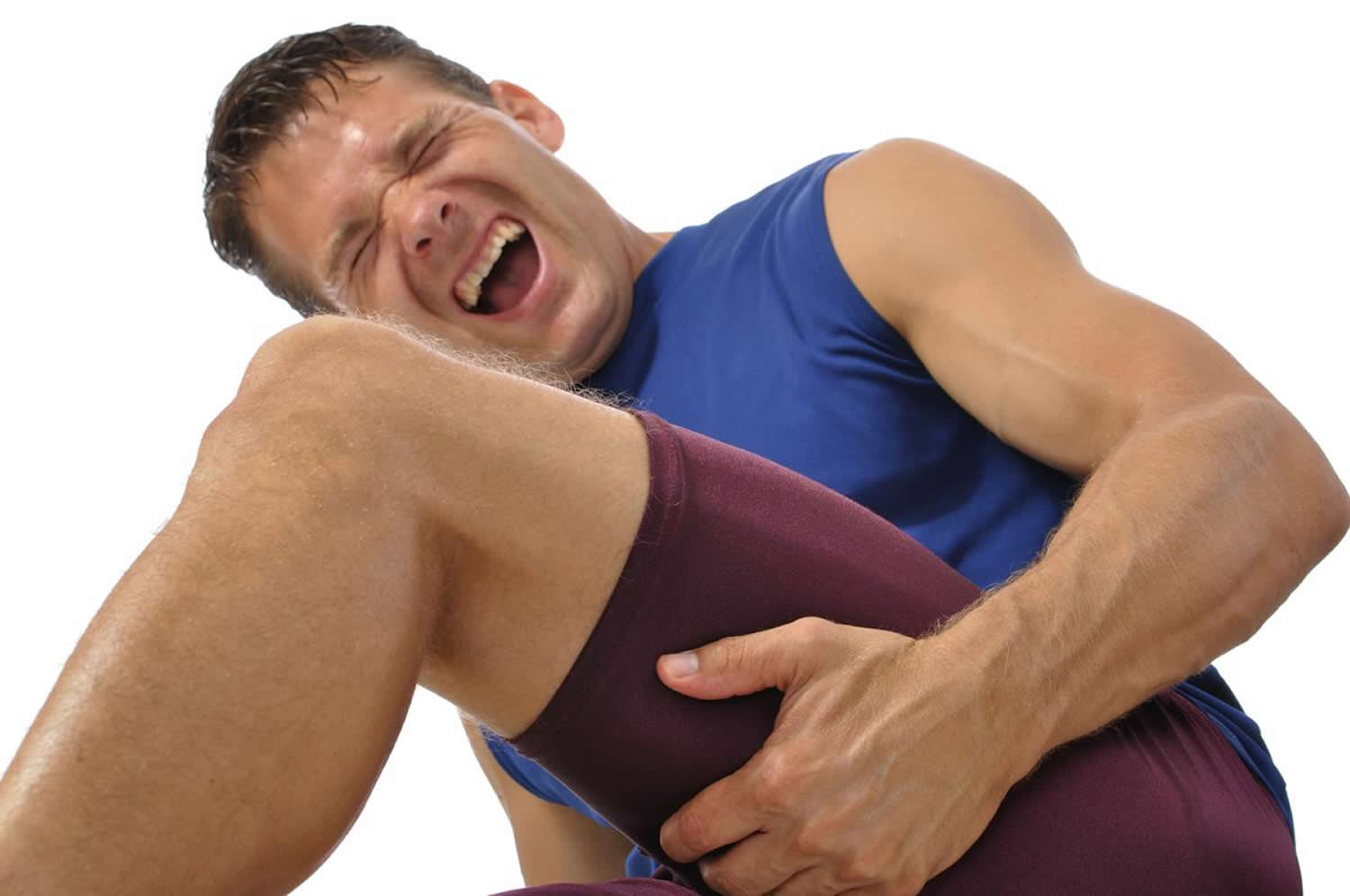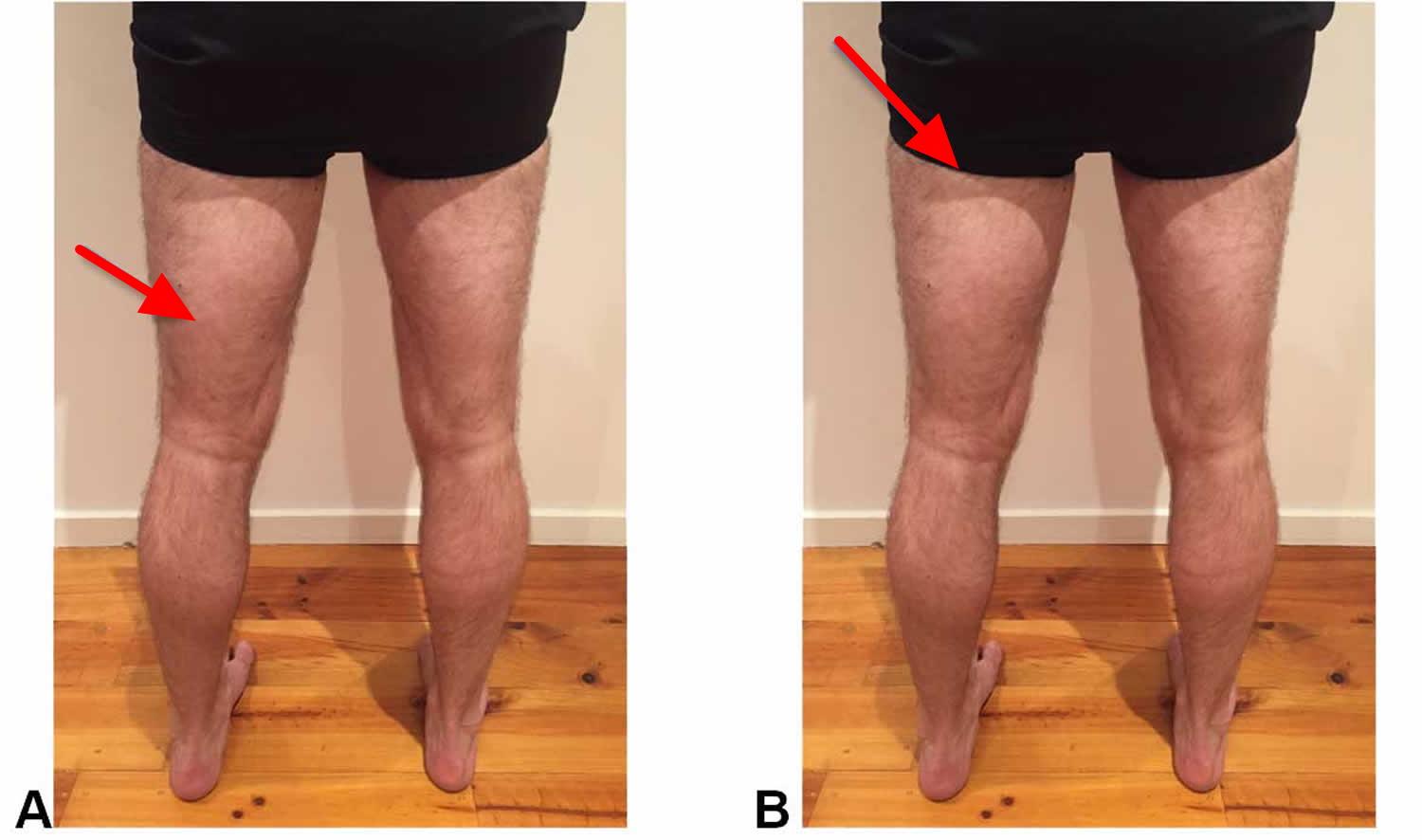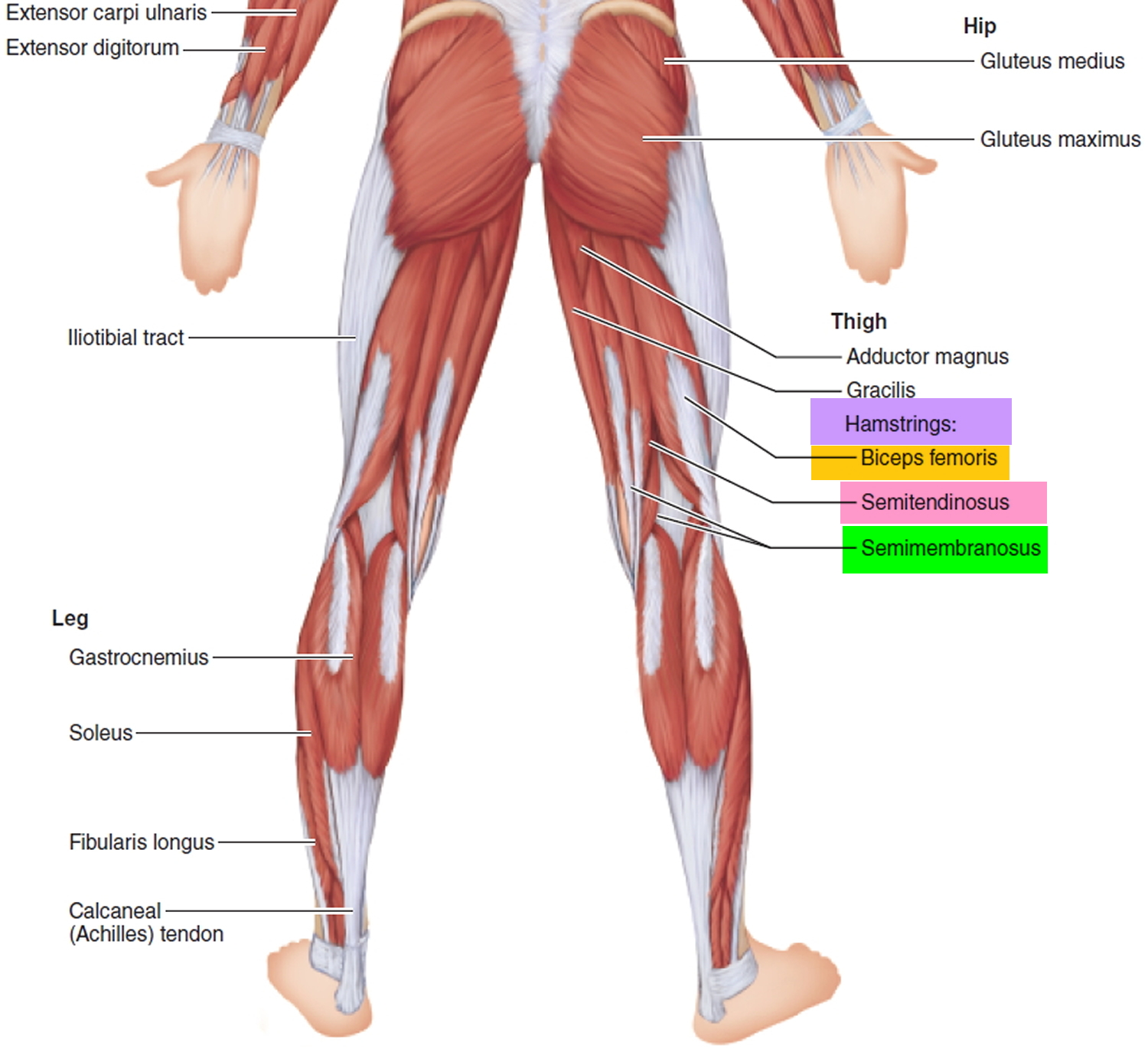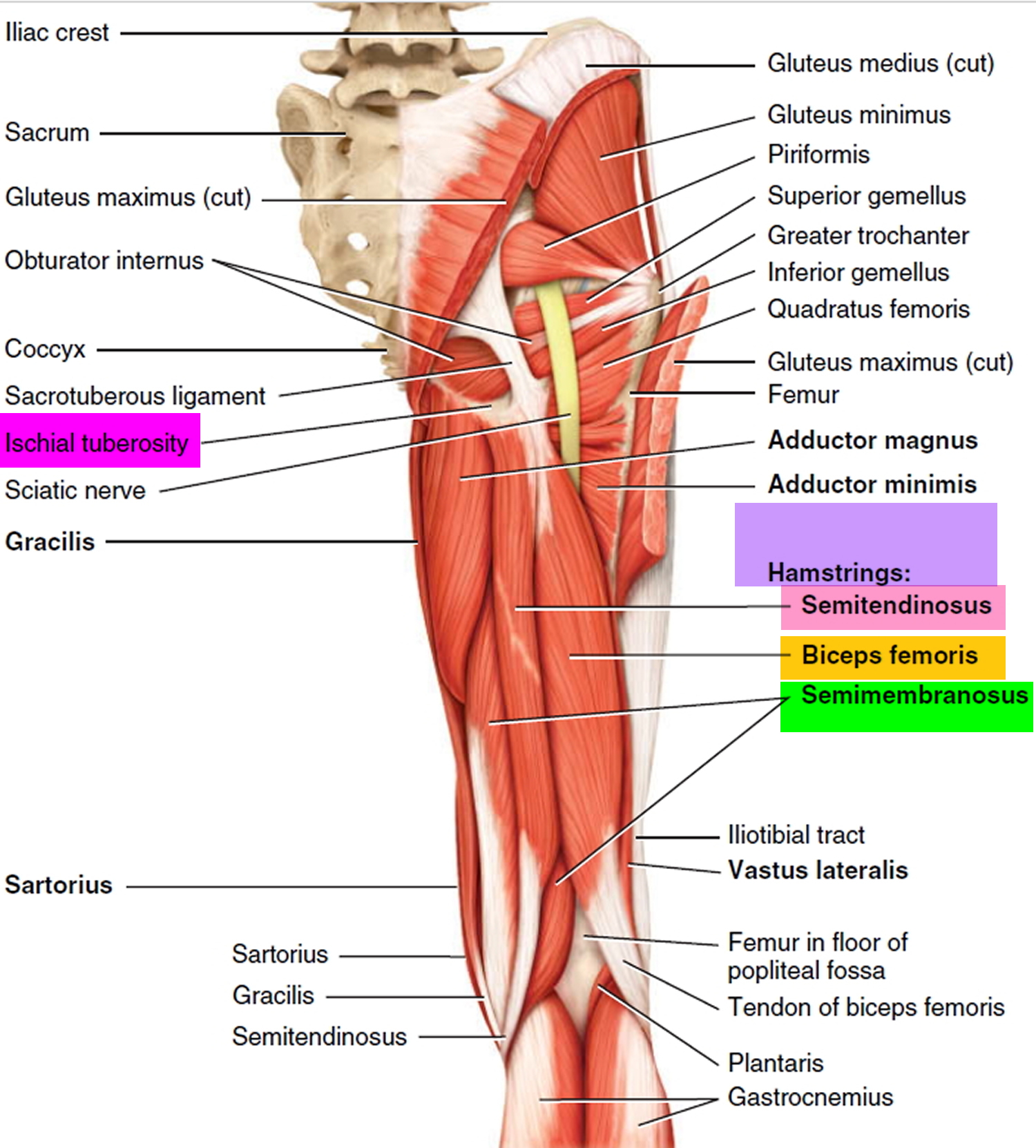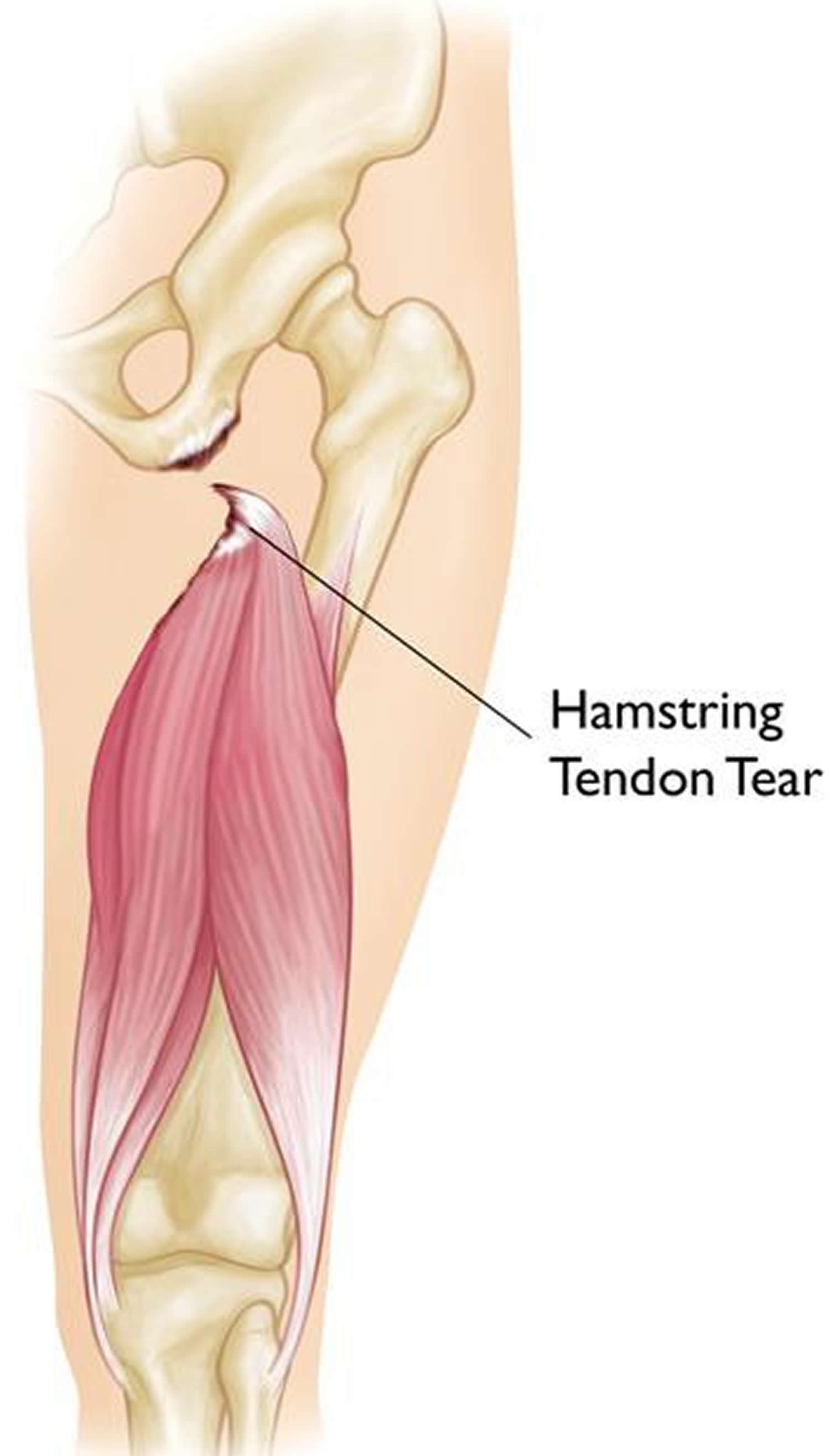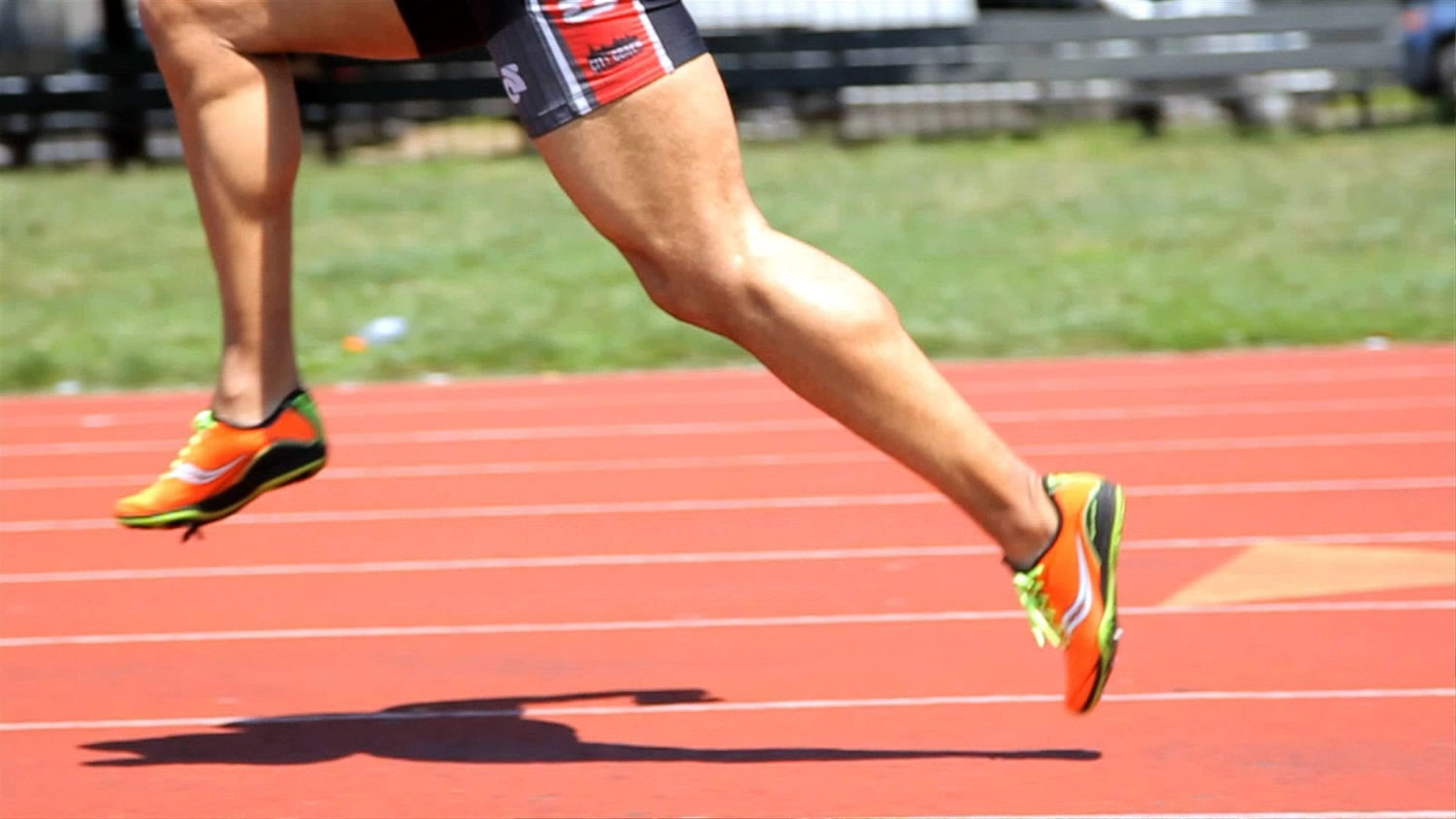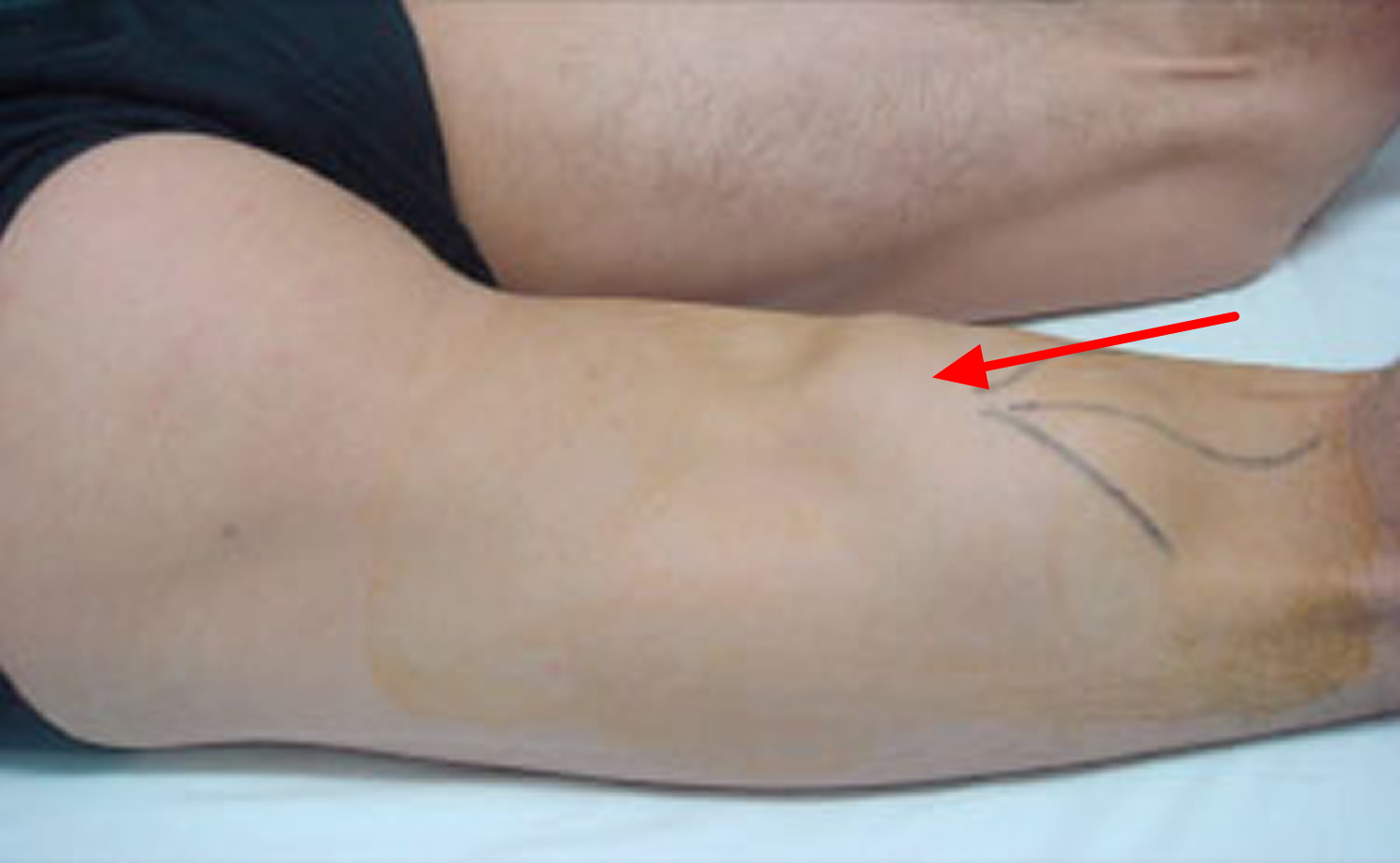Contents
What is hamstring injury
A hamstring injury is a strain or tear to the tendons or large hamstring muscles at the back of the thigh (see Figures 1 and 2). The term ‘hamstring’ also refers to the group of three muscles that run along the back of your thigh, from your hip to just below your knee.
Hamstring muscle injuries — such as a “pulled hamstring” — occur frequently in athletes. They are especially common in athletes who participate in sports that require sprinting with sudden stops and starts, such as runners, sprinters, soccer, tennis and basketball.
A pulled hamstring or strain is an injury to one or more of the muscles at the back of the thigh. Most hamstring injuries respond well to simple, nonsurgical treatments.
Hamstring muscle injuries happen when the muscle is put under too much stress, typically when it is stretched under pressure. The injury occurs not because the hamstring muscle isn’t flexible enough, but because the hamstring muscle isn’t producing enough force to support itself. A muscle might not produce enough force, either because it is not strong enough or it didn’t contract at the right time for a particular movement.
Hamstring injury is a common injury in athletes and can occur with different severities.
The three grades of hamstring injury are:
- Grade 1 – a mild muscle pull or strain
- Grade 2 – a partial muscle tear
- Grade 3 – a complete muscle tear
The length of time it takes to recover from a hamstring strain or tear will depend on how severe the hamstring injury is.
A minor muscle pull or strain (Grade 1 hamstring injury) may take a few days to heal, whereas it could take weeks or months to recover from a muscle tear (Grade 2 or 3 hamstring injury) and you’ll be unable to resume training or play sport during this time.
Most hamstring injuries occur in the thick, central part of the muscle or where the muscle fibers join tendon fibers.
In the most severe hamstring injuries, the tendon tears completely away from the bone. It may even pull a piece of bone away with it. This is called an avulsion injury (see Figure 3).
Depending on where in the muscle complex the tear has occurred will also be a factor in how long it takes for you to return to your activity. For example a tear near the top of the hamstring muscle where it joins into the pelvis and where the fibers are more tendinous will generally take longer to heal than a tear in center of the muscle belly.
Note: A tear in the muscle belly (as shown by the arrow in image A) will have a greater healing capacity than a tear which is nearer the insertion of the muscle (arrow in image B). One of the reasons for this is the greater blood supply in the muscle belly compared to at the insertion.
Consider seeing your doctor if you have any concerns about your injury, particularly if you think it’s a severe injury, it’s not healing, or your symptoms are getting worse.
Your doctor can also advise you about when you can return to your normal activities and what exercises you should do to aid your recovery in the meantime. They may be able to refer you to a physiotherapist for specialist treatment in some cases.
However, self-care measures such as rest, ice and over-the-counter pain medications are often all you need to relieve the pain and swelling associated with a hamstring injury. Rarely, surgery may be needed to repair a hamstring muscle or tendon.
Hamstring Anatomy
The hamstring muscles run down the back of the thigh and the hamstring muscles help you extend your leg straight back and bend your knee.. There are three hamstring muscles (Figures 1 and 2):
- Semitendinosus
- Semimembranosus
- Biceps femoris
They start at the bottom of the pelvis at a place called the ischial tuberosity. They cross the knee joint and end at the lower leg. Hamstring muscle fibers join with the tough, connective tissue of the hamstring tendons near the points where the tendons attach to bones.
The hamstring muscles aren’t used much while standing or walking, but they’re very active during activities that involve bending the knee, such as running, jumping and climbing.
Figure 1. Hamstrings
Figure 2. Hamstring muscles
Figure 3. Severe hamstring (grade 3) injury where the tendon has been torn from the bone (ischial tuberosity).
Hamstring injury complications
Returning to strenuous activities before your hamstring muscles are completely healed might cause an injury recurrence.
What causes hamstring injuries?
A hamstring injury can occur if any of the tendons or muscles are stretched beyond their limit (overload injury).
They often occur during sudden, explosive movements, such as sprinting, lunging or jumping. But they can also occur more gradually, or during slower movements that overstretch your hamstring.
Recurring injury is common in athletes and sportsmen, as you’re more likely to injure your hamstring if you’ve injured it before.
Regularly doing stretching and strengthening exercises, and warming up before exercise, may help reduce the risk of injuring your hamstring.
Muscle Overload
Muscle overload is the main cause of hamstring muscle strain. This can happen when the muscle is stretched beyond its capacity or challenged with a sudden load.
Hamstring muscle strains often occur when the muscle lengthens as it contracts, or shortens. Although it sounds contradictory, this happens when you extend a muscle while it is weighted, or loaded. This is called an “eccentric contraction.”
During sprinting, the hamstring muscles contract eccentrically as the back leg is straightened and the toes are used to push off and move forward. The hamstring muscles are not only lengthened at this point in the stride, but they are also loaded — with body weight as well as the force required for forward motion.
Like strains, hamstring tendon avulsions are also caused by large, sudden loads.
Figure 4. During sprinting, the hamstring muscles are lengthened and loaded as the back leg pushes off to propel the runner forward.
Risk Factors for hamstring injury
Several factors can make it more likely you will have a muscle strain, including:
Muscle tightness. Tight muscles are vulnerable to strain. Athletes should follow a year-round program of daily stretching exercises.
Muscle imbalance. When one muscle group is much stronger than its opposing muscle group, the imbalance can lead to a strain. This frequently happens with the hamstring muscles. The quadriceps muscles at the front of the thigh are usually more powerful. During high-speed activities, the hamstring may become fatigued faster than the quadriceps. This fatigue can lead to a strain.
Poor conditioning. If your muscles are weak, they are less able to cope with the stress of exercise and are more likely to be injured.
Muscle fatigue. Fatigue reduces the energy-absorbing capabilities of muscle, making them more susceptible to injury.
Choice of activity. Anyone can experience hamstring strain, but those especially at risk are:
- Athletes who participate in sports like football, soccer, basketball
- Runners or sprinters
- Dancers
- Older athletes whose exercise program is primarily walking
- Adolescent athletes who are still growing
Hamstring strains occur more often in adolescents because bones and muscles do not grow at the same rate. During a growth spurt, a child’s bones may grow faster than the muscles. The growing bone pulls the muscle tight. A sudden jump, stretch, or impact can tear the muscle away from its connection to the bone.
Should I stretch before exercising?
Your decision to stretch or not to stretch should be based on what you want to achieve. If the objective is to reduce injury, stretching before exercise is not helpful.
Research suggests that stretching before exercise is unlikely to reduce your risk of injury, improve your performance or prevent sore muscles.
However, there’s no evidence that stretching before or after exercise will do you any harm, either.
Your time would be better spent by warming up your muscles with light aerobic movements and gradually increasing their intensity.
If your objective is to increase your range of motion so that you can more easily do the splits, and this is more beneficial than the small loss in force, then you should stretch.
For most recreational exercisers, stretching before exercise is therefore a matter of personal preference. If you like stretching, do it, and if you don’t like stretching, don’t do it.
Does stretching before exercising reduce the risk of injury?
The evidence strongly suggests that pre-exercise stretching does not reduce the risk of injury. Professor Rob Herbert, Senior Principal Researcher Fellow with Neuroscience Research Australia, took part in the three largest randomizsed trials on the effects of stretching. They all concluded that stretching had little or no beneficial effect on reduction in injury risk.
The most recent and largest of the three studies found “a hint” of an effect on reducing injuries like ligament tears, muscle tears, strains and sprains. But Prof Herbert cautioned, “If stretching does cut your odds of one of these types of injuries, it’s by only a very small amount.”
Does stretching reduce soreness?
There is no evidence that stretching helps to reduce or prevent a type of pain that can show up a day or two after exercising – also called delayed onset muscle soreness (DOMS).
A 2011 review by Prof Herbert found that “muscle stretching, whether conducted before, after, or before and after exercise, does not produce clinically important reductions in delayed onset muscle soreness in healthy adults.”
Does stretching before exercise affect performance?
Research suggests that stretching before exercise makes your muscles weaker and slower, even though you might feel looser. For most performances, this would be detrimental,” says Dr Ian Shrier, a sports medicine clinician and researcher and Associate Professor at the Department of Family Medicine, at Montreal’s McGill University.
However, stretching also increases your range of motion. A ballerina might require stretching before performance to do a full split during the show. Even though she is weaker, her performance will be improved.
Dr Kay, who was the lead author on one of the largest reviews on pre-performance stretching, believes the reduction in performance from pre-exercise stretching has been overstated. It is likely that durations of stretch used in the warm-up routines of most recreational exercisers produce negligible and transient reductions in strength.
How should I warm up?
The purpose of warming up is to prepare mentally and physically for your chosen activity. A typical warm up will take at least 10 minutes and involve light aerobic movements and some dynamic stretching that mimics the movements of the activity you’re about to perform.
Gradually increasing the range of motion of these movements during the warm up will prepare the body for more intense versions of those movements during the sport itself. This process will raise your heart rate and increase the blood flow to your muscles, thereby warming them up.
Warm muscles are less stiff and work more efficiently. Increased blood flow enables more oxygen to reach the muscles and produce energy. The warm up also activates the nerve signals to your muscles, which results in faster reaction times.
Should I stretch after exercising?
There is some evidence that regular static stretching outside periods of exercise may increase power and speed, and reduce injury. The best time to stretch is when the muscles are warm and pliable. This could be during a yoga or pilates class, or just after exercising.
However, there is very limited evidence about specifically stretching after exercise. Since people tend not to set aside one time to stretch and one time for other activities, some scientists recommend that you stretch after exercise.
A post-exercise stretch will also slow down your breathing and heart rate, and bring the mind and body back to a resting state.
Hamstring injury prevention
As part of an overall physical conditioning program, regular stretching and strengthening exercises can help minimize your risk of hamstring injury. Try to be in shape to play your sport; don’t play your sport to get in shape.
If you have a physically demanding occupation, regular conditioning can help prevent injuries. Ask your doctor about appropriate conditioning exercises.
Hamstring injury symptoms
If you strain your hamstring while sprinting in full stride, you will notice a sudden, sharp pain in the back of your thigh. It will cause you to come to a quick stop, and either hop on your good leg or fall. You might also feel a “popping” or tearing sensation. Swelling and tenderness usually develop within a few hours. You may also experience bruising or discoloration along the back of your leg, as well as muscle weakness or an inability to put weight on your injured leg.
Additional symptoms may include:
- Swelling during the first few hours after injury
- Bruising or discoloration of the back of your leg below the knee over the first few days
- Weakness in your hamstring that can persist for weeks
Mild hamstring strains (Grade 1 hamstring injury) will usually cause sudden pain and tenderness the back of your thigh. It may be painful to move your leg, but the strength of the muscle shouldn’t be affected.
Partial hamstring tears (Grade 2 hamstring injury) are usually more painful and tender. There may also be some swelling and bruising at the back of your thigh and you may have lost some strength in your leg.
Severe hamstring tears (Grade 3 hamstring injury) will usually be very painful, tender, swollen and bruised. There may have been a “popping” sensation at the time of the injury and you’ll be unable to use the affected leg.
Hamstring injury diagnosis
People with hamstring strains often see a doctor because of a sudden pain in the back of the thigh that occurred when exercising.
During the physical examination, your doctor will ask about the injury and check your thigh for tenderness or bruising. He or she will palpate, or press, the back of your thigh to see if there is pain, weakness, swelling, or a more severe muscle injury.
Figure 5. Severe hamstring injury (grade 3) – in this severe tear of the hamstring tendon away from the bone, the muscle has balled up at the back of the thigh.
Imaging tests that may help your doctor confirm your diagnosis include:
- X-rays. An X-ray can show your doctor whether you have a hamstring tendon avulsion. This is when the injured tendon has pulled away a small piece of bone.
- Magnetic Resonance Imaging (MRI). This study can create better images of soft tissues like the hamstring muscles. It can help your doctor determine the degree of your injury.
Hamstring injury treatment
Treatment of hamstring strains will vary depending on the type of injury you have, its severity, and your own needs and expectations.
The goal of any treatment — nonsurgical or surgical — is to help you return to all the activities you enjoy. Following your doctor’s treatment plan will restore your abilities faster, and help you prevent further problems in the future.
New Developments
Platelet-rich plasma is currently being investigated for its effectiveness in speeding the healing of hamstring muscle injuries. Platelet-rich plasma is a preparation developed from a patient’s own blood. It contains a high concentration of proteins called growth factors that are very important in the healing of injuries.
A few treatment centers across the country are incorporating platelet-rich plasma injections into the nonsurgical treatment regimen for some hamstring muscle injuries. However, this method is still under investigation and more research is necessary to prove platelet-rich plasma’s effectiveness.
How to treat a hamstring injury
For immediate self-care of a hamstring injury, try the R.I.C.E. approach — rest, ice, compression, elevation. If your injury is worse than a minor muscle strain, you’ll want your doctor and physical therapist to help you with this process.
During the first two or three days, you should care for your injury using RICE therapy:
- Rest – keep your leg as still as you possibly can and avoid physical activity. Your doctor may recommend using crutches in more severe cases.
- Ice – apply cold packs (a bag of frozen peas wrapped in a tea towel will also work) to your hamstring for 15 to 20 minutes every two to three hours during the day. Cold reduces pain, swelling and inflammation in injured muscles, joints and connective tissues. It may also slow bleeding if a tear has occurred. Don’t apply ice directly to your skin. If your skin turns white when it’s being iced, stop treatment immediately. If you have vascular disease, diabetes or decreased sensation, talk with your doctor before applying ice.
- Compression – compress or bandage the thigh to limit any swelling and movement that could cause further damage. You can use a simple elastic bandage or elasticated tubular bandage available from a pharmacy. Begin wrapping at the end farthest from your heart. Loosen the bandage if the pain increases, the area becomes numb or swelling occurs below the wrapped area.
- Elevation – keep your leg raised and supported on a pillow as much as possible, to help reduce any swelling. If possible, elevate your leg higher than the level of your heart. Gravity helps reduce swelling by draining excess fluid.
Regular painkillers, such as paracetamol or a non-steroidal anti-inflammatory drug (NSAID) cream or gel, may also help relieve the pain.
Short-term use of oral NSAIDs, such as ibuprofen tablets, can also help reduce swelling and inflammation. However, these aren’t suitable for everyone. Check the leaflet that comes with your medication to see if you can take it.
Immobilization. Your doctor may recommend you wear a knee splint for a brief time. This will keep your leg in a neutral position to help it heal.
Physical therapy. Once the initial pain and swelling has settled down, physical therapy can begin. Specific exercises can restore range of motion and strength.
A therapy program focuses first on flexibility. Gentle stretches will improve your range of motion. As healing progresses, strengthening exercises will gradually be added to your program. Your doctor will discuss with you when it is safe to return to sports activity.
Recovery
Most people who injure their hamstrings will recover full function after completing a rehabilitation plan. Early treatment with a plan that includes the RICE protocol and physical therapy has been shown to result in better function and quicker return to sports.
To prevent reinjuring your hamstring, be sure to follow your doctor’s treatment plan. Return to sports only after your doctor has given you the go-ahead. Reinjuring your hamstring increases your risk of permanent damage. This can result in a chronic condition.
Gentle exercises and stretches
Returning to strenuous exercise too quickly could make your injury worse, but avoiding exercise for too long can cause your hamstring muscles to shrink and scar tissue to form around the tear.
To avoid this, you should start doing gentle hamstring stretches after a few days, when the pain has started to subside.
This should be followed by a programme of gentle exercise, such as walking and cycling, and hamstring strengthening exercises.
Your doctor can give you further advice and, if necessary, refer you to a physiotherapist for a suitable exercise programme.
To avoid injuring yourself again, you should only return to a full level of activity when your hamstring muscles are strong enough. Your physiotherapist or doctor will be able to advise you about this.
Many people need to avoid sports for at least a few weeks, but the length of time you need off will depend on the severity of your injury.
Hamstring stretches injury
Research suggests that stretching before exercise is unlikely to reduce your risk of injury, improve your performance or prevent sore muscles.
However, there’s no evidence that stretching before or after exercise will do you any harm, either. The upshot is if you enjoy stretching, or it is a staple in your exercise routine, there’s no reason to stop.
What’s the point of stretching?
Stretching for sport and exercise improves flexibility, which increases the ability of a joint to move through its full range of motion; in other words, how far it can bend, twist and reach. Some activities, such as gymnastics, require more flexibility than others, such as running.
Different types of stretches
- Static stretch: stretching a muscle to the point of mild discomfort and holding that position, typically for at least 30 seconds or longer.
- Proprioceptive neuromuscular facilitation: methods vary, but typically proprioceptive neuromuscular facilitation involves holding a stretch while contracting and relaxing the muscle.
- Dynamic stretch: performing gentle repetitive movements, such as arm swings, where one gradually increases the range of motion of the movement, but always remains within the normal range of motion.
- Ballistic or bouncing stretches: involves going into a stretch and performing bouncing or jerking movements to increase range of motion.
Most of the research on stretching has focussed on static stretching; there is less evidence on other forms.
What happens when you stretch?
While the exact mechanics of what happens are not fully understood, regular stretching is thought to increase flexibility, both by making muscles more supple and by retraining the nervous system to tolerate stretching further. Flexibility from regular stretching gradually disappears once you stop stretching – typically after four weeks.
It’s unclear whether the increase in range of motion of a joint is due to physical changes in the muscles that control those joints, or just a greater tolerance to stretch. Some scientists believe that there must be some changes at the muscle-tendon unit level, as just increasing tolerance would not have the scale of effect that can be seen with some stretching programmes.
How much flexibility do you need?
It depends on your activity. The flexibility demands of a gymnast or a ballet dancer are clearly different to those of a runner. There is little to be gained for a jogger or runner from having the flexibility of a gymnast.
To generate power during exercise, the muscles and tendons store and release energy like a spring. Too much flexibility may reduce the muscle’s natural spring, which may be detrimental for activities involving running, jumping and sudden changes in direction, such as running, football or basketball.
However, too little flexibility may increase the risk of muscle strain injury, as the muscles are unable to lengthen and absorb this energy.
Surgical Treatment
Surgery is most often performed for tendon avulsion injuries, where the tendon has pulled completely away from the bone. Tears from the pelvis (proximal tendon avulsions) are more common than tears from the shinbone (distal tendon avulsions).
Surgery may also be needed to repair a complete tear within the muscle.
Procedure. To repair a tendon avulsion, your surgeon must pull the hamstring muscle back into place and remove any scar tissue. Then the tendon is reattached to the bone using large stitches or staples.
A complete tear within the muscle is sewn back together using stitches.
Rehabilitation. After surgery, you will need to keep weight off of your leg to protect the repair. In addition to using crutches, you may need a brace that keeps your hamstring in a relaxed position. How long you will need these aids will depend on the type of injury you have.
Your physical therapy program will begin with gentle stretches to improve flexibility and range of motion. Strengthening exercises will gradually be added to your plan.
Rehabilitation for a proximal hamstring reattachment typically takes at least 6 months, due to the severity of the injury. Distal hamstring reattachments require approximately 3 months of rehabilitation before returning to athletic activities. Your doctor will tell you when it is safe to return to sports.
